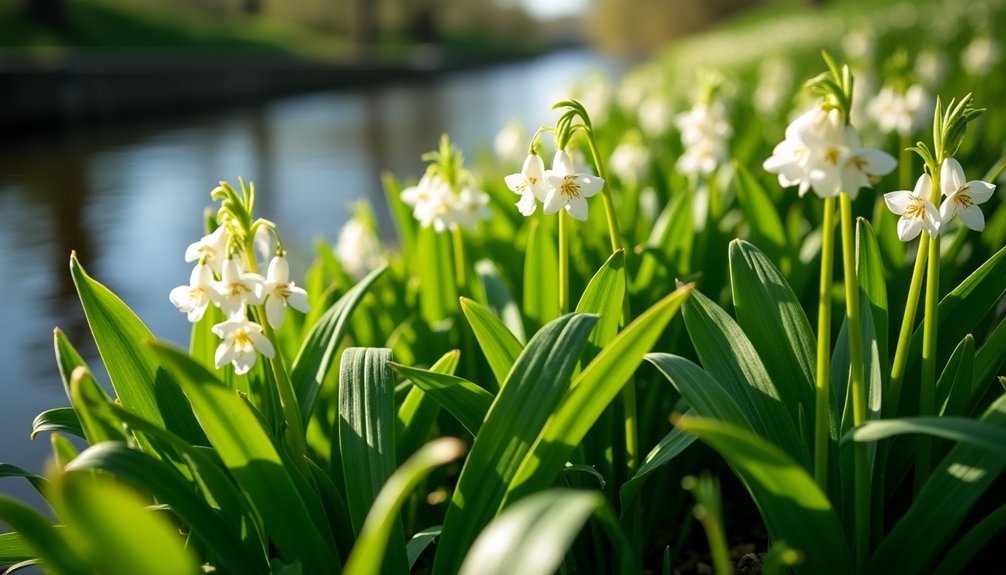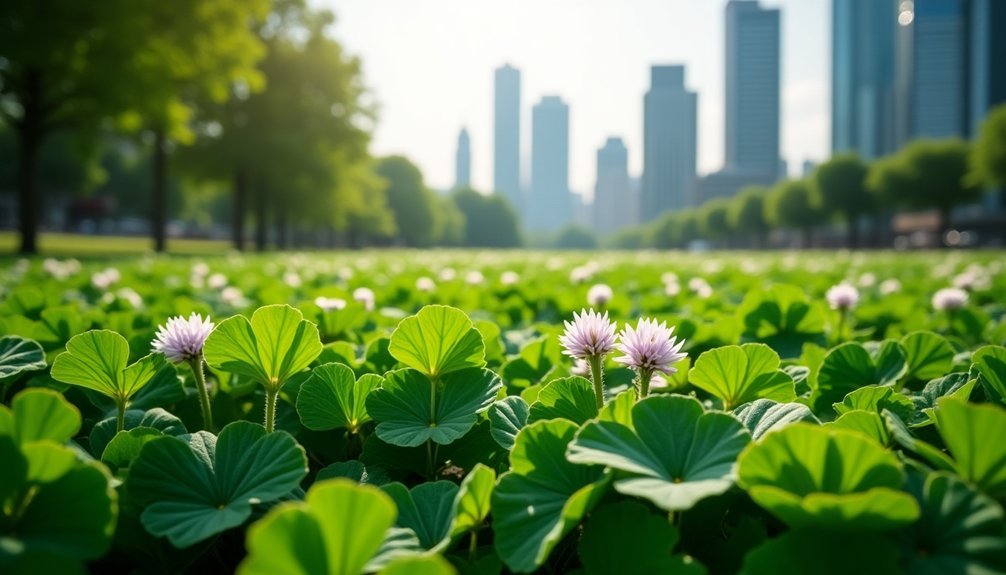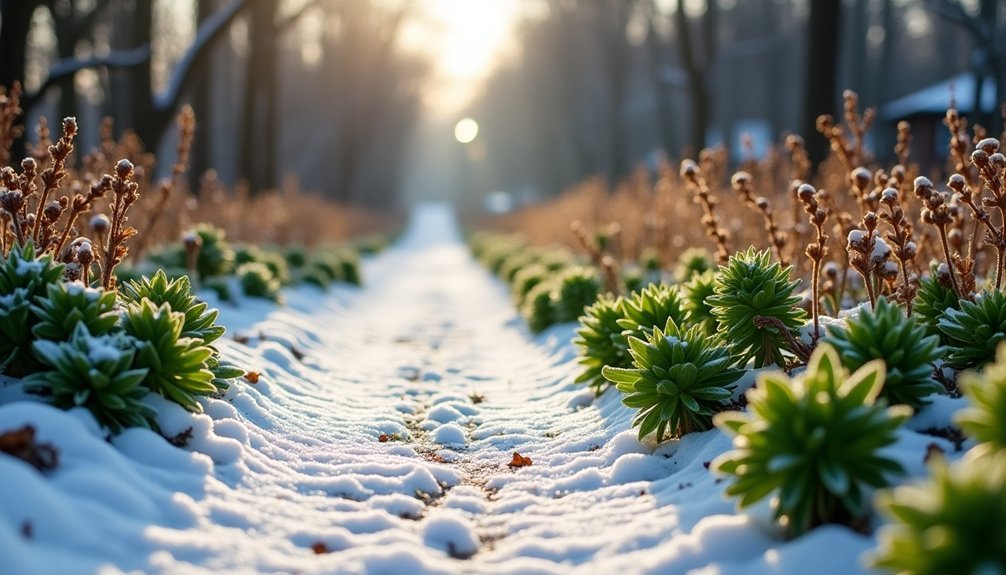City foragers can find wild garlic along canal verges from March to May, dandelions in community parks during June, and white clover in urban green belts throughout August. By September, seek chicory root in abandoned lots, especially after the first frost. Winter months (December-February) offer surprising harvests in sheltered valley areas, away from roadways. Each location offers unique seasonal treasures that you'll learn to identify with the right knowledge and tools.
Spring's Hidden Treasures: Wild Garlic Patches Along Canal Verges

The humble canal verge transforms into a forager's paradise each spring when wild garlic (Allium ursinum) emerges in vibrant green carpets.
Nature's hidden bounty transforms ordinary canal paths into aromatic feasts for the observant spring forager.
You'll recognize it by its broad, lance-shaped leaves and unmistakable garlic scent when crushed.
From March to early May, these damp, shaded areas yield the most tender leaves—perfect for pestos, salads, and soups.
When harvesting, use scissors to snip just a few leaves from each plant, leaving the bulbs intact to preserve colonies.
Be cautious of toxic lookalikes like lily of the valley.
The white, star-shaped flowers that bloom on stems up to 45cm tall are also edible, offering a stronger flavor ideal for pickling.
Remember to seek permission before foraging on private land, as digging bulbs without permission is strictly illegal and damages these beautiful woodland plants.
Early Summer Delights: Dandelion Harvesting in Community Parks
While most city dwellers rush past the bright yellow dots speckling urban greenspaces, savvy foragers recognize dandelions as early summer's nutritional goldmine.
Community parks offer ideal harvesting grounds where these resilient plants thrive in disturbed soil with minimal maintenance. These nutrient-rich plants contain vitamins and minerals that can boost your health naturally.
For the best harvest experience, you'll want to:
- Time your visit – Arrive in early mornings when leaves are less bitter and before park maintenance crews begin their rounds
- Bring proper tools – Pack gloves to prevent sap stains and scissors for clean cuts
- Focus on safety – Choose areas away from roadways and dog-walking paths, ensuring plants haven't been treated with chemicals
Remember to harvest responsibly by taking only what you need and leaving plenty for regrowth and other foragers.
August Abundance: Clover Fields in Urban Green Belts

As summer heat reaches its peak, August transforms urban green belts into lush carpets of white clover, offering city foragers an abundant harvest opportunity. You'll find these nitrogen-fixing plants thriving along the urban-rural gradient, with city specimens containing fewer defensive toxins than their rural counterparts. Research confirmed that urban white clover produces less hydrogen cyanide than rural populations worldwide.
| Location Type | Safety Level | Best Uses |
|---|---|---|
| City Parks | Higher | Raw salads |
| Green Belts | High | Teas, baking |
| Golf Courses | Moderate | Medicinal |
| Urban Trails | High | Flour substitute |
| Community Gardens | Highest | All purposes |
For ideal harvesting, look for regularly mowed areas where clover grows abundantly with minimal maintenance. These micro-ecosystems not only provide you with nutritious forage but also support local pollinators and contribute to urban biodiversity conservation. Remember to gather only what you need, leaving plenty for bees and other wildlife.
Fall's Forgotten Bounty: Chicory Root Spots in Abandoned Lots
Many hidden treasures await urban foragers in autumn's cooling embrace, with chicory root standing as perhaps the most overlooked bounty of the season.
After the first frost hits your city, grab your digging tools and head to abandoned lots where disturbed soil creates perfect conditions for this blue-flowered plant.
For ideal harvesting success:
- Focus on first-year plants with their basal rosette of dandelion-like leaves
- Look for areas away from traffic pollution, especially in open fields or near old pasture land
- Dig carefully after fall rains when soil is softer, making the long taproots easier to extract without breaking
You'll recognize chicory by its tall stalks and distinctive blue flowers that persist into early fall. These flowers typically open around 7 a.m. and close by early afternoon, so plan your scouting trips accordingly.
Winter Foraging: Protected Edibles Along Sheltered Roadsides

Contrary to popular belief, winter offers determined urban foragers surprising harvesting opportunities even during the coldest months.
You'll find your best success in sheltered areas like valleys and forest edges, where plants remain protected from harsh weather.
When foraging near roadways, maintain a 50-100 foot distance to avoid heavy metals and chemical contamination from de-icers. Foraging uphill from roads can significantly reduce your exposure to contaminated runoff containing harmful pollutants.
Look for resilient edibles like dandelion roots, chicory, and wintercress—the latter providing essential vitamins when fresh produce is scarce.
Follow animal tracks to discover hidden food sources, but always harvest responsibly, leaving plenty for wildlife.
Check for plants that become more palatable after frost, like Jerusalem artichokes with their nutritious tubers.
Remember to properly identify everything you collect—winter's sparse vegetation can make look-alikes particularly dangerous.
Frequently Asked Questions
How Do I Identify Poisonous Look-Alikes in Urban Environments?
You'll identify poisonous look-alikes by learning specific features like leaf patterns, berry colors, and mushroom gills. Always consult multiple identification sources and avoid consuming anything you're not 100% certain about.
Are Permits Required for Foraging in City Parks?
Yes, you'll typically need permits for foraging in city parks. Regulations vary by location, with some places prohibiting plant removal entirely. Check with local park authorities before collecting anything to avoid potential fines.
How Can I Test Soil for Contamination Before Harvesting?
You can collect soil samples and use at-home test kits for basic screening. For thorough results, send samples to local labs, consult extension offices, or use XRF scanners for heavy metals detection.
What Tools Are Essential for an Urban Foraging Kit?
You'll need a hand lens, pocket knife, bags for collection, plant identification guide, and gloves. Don't forget a smartphone for research, small containers for berries, and a first aid kit for safety.
How Do Weather Patterns Affect Urban Plant Toxicity Levels?
Weather patterns greatly affect plant toxicity. You'll notice higher toxicity during droughts as plants concentrate compounds, while heavy rainfall can leach toxins or increase fungal contamination that produces secondary toxic metabolites.
In Summary
You've now got a year-round foraging calendar for your urban adventures. Remember, you're never far from nature's pantry, even in concrete jungles. Start with small harvests, respect public spaces, and you'll soon recognize edible treasures hiding in plain sight. As you develop this skill, you'll connect with your city differently, seeing potential meals where others see only landscaping.





Leave a Reply